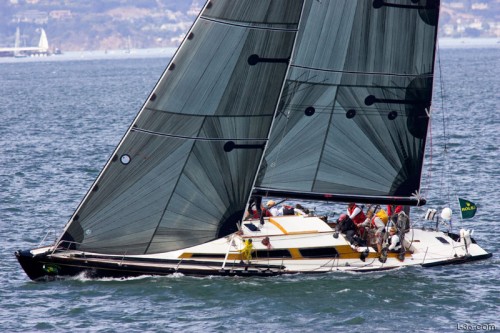Small Things - Big Wins

Boats that win consistently have spent the time and
effort to take care of all the small things that make the difference
between winning and losing races. Do you put the time and effort in to
accomplish that? Start with the basics, boat bottom. You can have a good
bottom job by doing a light sanding of the existing bottom, spraying on
two coats of bottom pain, and sanding it with 180 or maybe 220 grit
sandpaper. Put it in the water and let the diver wipe it down every few
weeks which will smooth the finish a little more, and there you are. Or
you can spend a day with a few of the crew and long board sand the
bottom, filling any low spots and taking down any high spots as you go,
spray two or three coats of bottom paint on and sanding with at least
220 grit paper in between coats, and finish by sanding the bottom out
with 600 grip paper and then burnishing that. It's a few days of hard
work or a couple of thousand extra dollars at the yard, but the result
is a boat that will be 3 to 6 seconds a mile faster in all conditions
and all points of sail.
How about weight? I have a friend that was sailing
the same type of boat I was sailing and he asked how we could possibly
always be faster than he was. His boat was right next to ours and a
quick check showed his boat was sitting almost an inch deeper in the
water than ours was. The difference? At least once a year we completely
empty the boat and then make sure we put nothing back on that we don't
need for racing. He had fishing gear, a some pots, pans, and dishes, a
few sets of foul weather gear, a delivery main, some books, a bunch of
CD's and even a small 12 volt TV.
When it comes to rigging there are two rules. Make
sure that you have the necessary rigging so that the crew can accomplish
all their jobs quickly and easily, and make sure that is all there is.
Our rule is that if something doesn't work perfectly once wait and see
what happens in the future, if it doesn't work correctly twice - FIX IT.
Make sure that all control line lead to areas that the appropriate crew
can reach them, Make sure they have enough purchase to do the job, but
keep friction to a minimum. Jib leads should be easily adjustable
because they need to be moved during a race as wind, sea, or tactical
considerations change.
Have you checked you rig lately? You should, and it
should be done at least a few times a year. Go out sailing in medium air
and sight up the mast while sailing hard on the wind. If the mast isn't
straight side to side on both tacks then spend some time tuning it until
it is. How about rake? We change our depending on the wind strength for
the day. In light air you need a little more rake to give you some
weather helm and on windy days you need less rake because as the boat
heels over it generates more helm on its own and you will find that you
end up dragging the rudder through the water at a great angle and with a
lot more drag.
And last, at last for this article, is crew work.
Top boats have top crews and that doesn't mean having a bunch of pro's
on board. It means having a crew that is committed to sailing with you
on a regular basis that understands what their jobs are and are willing
to spend some time practicing to accomplish them. There is no better
feeling than going around the weather mark and having that "perfect
spinnaker set", or that perfect gybe. If you don't enjoy that on a
regular basis get your crew together for some practice time. It will
work wonders for crew moral and for your finish position!
Each on of these things may only add a few seconds
per mile, but put them all together and they will make a significant
difference over the length of a race. So look at your results and see
how many seconds per mile you generally are out of first place. The
difference won't generally be one big thing or some super secret you
don't know, it mostly likely is just a matter of taking the small things
that will add up to the big difference!
For more from Elliott Pattison Sailmakers click HERE.
NOTICE: Some pages have affiliate links to Amazon. As an Amazon Associate, I earn from qualifying purchases. Please read website Cookie, Privacy, and Disclamers by clicking HERE. To contact me click HERE. For my YouTube page click HERE